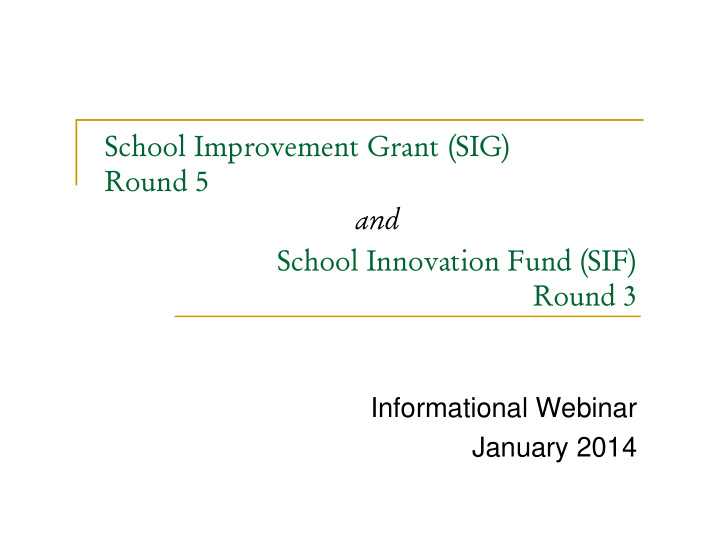



School Improvement Grant (SIG) Round 5 and School Innovation Fund (SIF) Round 3 Informational Webinar January 2014
Webinar Agenda Background Priority Schools - options and eligibility Overview of RFPs Proposal Narratives District-level and School-level Budgets and Budget Guidance Scoring Application and Submission 2
Background - Priority Schools Among the lowest performing schools in the state based on combined ELA/math performance, or significantly low graduation rates List of Priority Schools – http://www.p12.nysed.gov/accountability/ESEADesignations.html These schools must implement a whole-school reform model that fully incorporates federal principles for school turnaround ESEA Waiver – http://usny.nysed.gov/docs/10-things-to-know-about-the-esea-waiver.pdf 3
Background – Options for Priority Schools Options Funding Features Implement 1 of 4 models SIG plan Competitive • Turnaround • Restart • Transformation • Closure Implement 1 of 6 whole- SIF plan Competitive school redesign frameworks Whole-school plan based SURR/SCEP LEA-Funded on seven (7) USED plan turnaround principles 4
Background - Eligibility Priority Schools not currently receiving either SIG or SIF funding LEAs may apply for both SIG and SIF (may only accept one if a school is awarded both) LEAs must be in compliance with Education Law 3012(c) regarding APPR throughout the entire grant period http://open.nysenate.gov/legislation/bill/A11171 5
Overview of RFPs – School Improvement Grant (SIG) and School Innovation Fund (SIF) Essential Similarities Designed to promote focused and sustainable school improvement Competitive grants with a minimum scoring threshold of 65 to be awarded District-level plan, school-level plan, budget Three-year funding period APPR required for duration of the grant 6
Overview of RFPs – School Improvement Grant (SIG) and School Innovation Fund (SIF) Essential Differences (SIF) four federal models or (SIF) six whole-school design frameworks Educational partner organization (EPO) required for all SIF frameworks EPO required for SIG Restart only Maximum funding: (SIG) $1,000,000 or (SIF) $750,000 7
Overview of RFPs - Intervention Models School Improvement Grant (SIG) Turnaround , Restart , Transformation and Closure Federal Guidance: http://www2.ed.gov/programs/sif/sigguidance03012012.doc School Innovation Fund (SIF) College Pathways School Design Community-Oriented School (wrap-around services) Design Arts and/or Cultural Education School Design Career and Technical Education (CTE) School Design Virtual/Blended/Online School Design Network-Affiliated School 8
Proposal Narratives General Points of Emphasis for Proposal Development Specificity and information-rich description Clear evidence of capacity to implement: Board policies and/or procedures Contractual provisions Clearly articulated labor-management agreements Clear evidence of school and community input in the plan 9
Proposal Narratives District-level Plan (20 points) District Overview Operational Autonomies District Accountability and Support Teacher and Leader Pipeline External Partner Recruitment, Screening and Matching Enrollment and Retention Policies, Practices and Strategies District-level Labor-Management Collaboration 10
Proposal Narratives School-level Plan (60 points) School Overview Needs Assessment School Model/Framework Selection Leadership Instructional Staff Partnerships Organizational Plan Educational Plan Training, Support, and PD Stakeholder Involvement and Communication Project Plan and Timeline 11
Budget and Budget Guidance (20 points) Budget Narrative : Clear explanation/justification of costs Specific identification of all funding sources Strategies for sustainability Budget Forms : Year-One Implementation Period FS-10 Budget Summary Chart 12
Additional Budget Guidance Budgeted items must be closely connected to organizational and pedagogical needs and purposes identified in the plan Be thoughtful about budget requests for “supplies and materials” (e.g., technology, office supplies, etc.) District costs must be associated with administration and support, and may not exceed 10% of total funding request 13
Scoring Scoring of application based on 100 possible points District-level plan (20 points) School-level plan (60 points) District/school budget and narrative (20 points) 65-point threshold for award consideration Scoring rubric Required elements Refer to Submission Checklist Applications must include ALL required elements 14
Submission Both SIG and SIF applications may be found at: http://usny.nysed.gov/rttt/rfp/ Complete applications must be successfully uploaded through Review Room by 3:00 p.m. on February 28, 2014 http://nysed- schoolturnaround.myreviewroom.com/ A complete original hardcopy (plus one copy) must be postmarked by February 28, 2014 15
Submission (cont.) Letters of Intent are requested, and should be submitted through Review Room by 5:00 p.m. on February 14, 2014 Notification Letters will be sent to districts in late April, 2014 M/WBE requirements Implementation Period begins June 1, 2014 (ends June 30, 2015) 16
Submission (cont.) SIG/SIF Application Questions Must be received by 5:00 p.m. on January 31, 2014 SIG: SIGAPP2014@mail.nysed.gov SIF: SIFGRANT@mail.nysed.gov Questions and Answers posted Posted by February 7, 2014 http://usny.nysed.gov/rttt/rfp Review Room Questions Technical assistance for electronic submission only Tracy Farrell at tfarrell@mail.nysed.gov 17
School Improvement Grant (SIG) Round 5 and School Innovation Fund (SIF) Round 3 Thank You NYSED School Turnaround Office 18
Recommend
More recommend